First-Principles Calculations and Experimental Study of H+-Irradiated Zr/Nb Nanoscale Multilayer System
Abstract
1. Introduction
2. Materials and Methods
2.1. Sample Preparation
2.2. Experimental Methods
2.3. Ab Initio Calculations
3. Results and Discussion
3.1. Microstructure of As-Deposited Zr/Nb Multilayer Coatings
3.2. First-Principles Calculations of Zr/Nb Multilayer Coatings
3.3. Depth Profiling and Defect Characterization of Zr/Nb Nanoscale Multilayers after H+ Irradiation
4. Conclusions
Author Contributions
Funding
Institutional Review Board Statement
Informed Consent Statement
Data Availability Statement
Acknowledgments
Conflicts of Interest
References
- Bull, S.J. Size effects in the mechanical response of nanoscale multilayer coatings on glass. Thin Solid Film. 2014, 571, 290–295. [Google Scholar] [CrossRef]
- Fazel, Z.A.; Elmkhah, H.; Fattah-Alhosseini, A.; Babaei, K.; Meghdari, M. Comparing electrochemical behavior of applied CrN/TiN nanoscale multilayer and TiN single-layer coatings deposited by CAE-PVD method. J. Asian Ceram. Soc. 2020, 8, 510–518. [Google Scholar] [CrossRef]
- Contreras, E.; Galindez, Y.; Rodas, M.A.; Bejarano, G.; Gómez, M.A. CrVN/TiN nanoscale multilayer coatings deposited by DC unbalanced magnetron sputtering. Surf. Coat. Technol. 2017, 332, 214–222. [Google Scholar] [CrossRef]
- Chen, J.; Geng, M.; Li, Y.; Yang, Z.; Chai, Y.; He, G. Erosion Resistance and Damage Mechanism of TiN/ZrN Nanoscale Multilayer Coating. Coatings 2019, 9, 64. [Google Scholar] [CrossRef]
- Puchi-Cabrera, E.S.; Staia, M.H.; Iost, A. Modeling the composite hardness of multilayer coated systems. Thin Solid Film. 2015, 578, 53–62. [Google Scholar] [CrossRef]
- Wang, L.; Wang, M.; Chen, H. Electrochemical Corrosion Behavior of TiAlN/CrN Nanoscale Multilayer Coatings by Multi-Arc Ion Plating in 3.5% NaCl Solution. Corrosion 2020, 76, 628–638. [Google Scholar] [CrossRef]
- Demkowicz, M.J.; Hoagland, R.G.; Hirth, J.P. Interface structure and radiation damage resistance in Cu-Nb multilayer nanocomposites. Phys. Rev. Lett. 2008, 100, 136102. [Google Scholar] [CrossRef]
- Gao, Y.; Yang, T.; Xue, J.; Yan, S.; Zhou, S.; Wang, Y.; Kwok, D.T.K.; Chu, P.K.; Zhang, Y. Radiation tolerance of Cu/W multilayered nanocomposites. J. Nucl. Mater. 2011, 413, 11–15. [Google Scholar] [CrossRef]
- Wei, Q.M.; Li, N.; Mara, N.; Nastasi, M.; Misra, A. Suppression of irradiation hardening in nanoscale V/Ag multilayers. Acta Mater. 2011, 59, 6331–6340. [Google Scholar] [CrossRef]
- Demkowicz, M.J.; Wang, Y.Q.; Hoagland, R.G.; Anderoglu, O. Mechanisms of He escape during implantation in CuNb multilayer composites. In Nuclear Instruments and Methods in Physics Research Section B: Beam Interactions with Materials and Atoms; Elsevier: Amsterdam, The Netherlands, 2007; Volume 261, pp. 524–528. [Google Scholar]
- Ham, B.; Zhang, X. High strength Mg/Nb nanolayer composites. Mater. Sci. Eng. 2011, 528, 2028–2033. [Google Scholar] [CrossRef]
- Thorsen, P.A.; Bilde-Sørensen, J.B.; Singh, B.N. Bubble formation at grain boundaries in helium implanted copper. Scr. Mater. 2004, 51, 557–560. [Google Scholar] [CrossRef]
- Han, W.Z.; Demkowicz, M.J.; Fu, E.G.; Wang, Y.Q.; Misra, A. Effect of grain boundary character on sink efficiency. Acta Mater. 2012, 60, 6341–6351. [Google Scholar] [CrossRef]
- Chen, E.Y.; Deo, C.; Dingreville, R. Irradiation resistance of nanostructured interfaces in Zr-Nb metallic multilayers. J. Mater. Res. 2019, 34, 2239–2251. [Google Scholar] [CrossRef]
- Laptev, R.; Lomygin, A.; Krotkevich, D.; Syrtanov, M.; Kashkarov, E.; Bordulev, Y.; Siemek, K.; Kobets, A. Effect of Proton Irradiation on the Defect Evolution of Zr/Nb Nanoscale Multilayers. Metals 2020, 10, 535. [Google Scholar] [CrossRef]
- Frutos, E.; Callisti, M.; Karlik, M.; Polcar, T. Length-scale-dependent mechanical behaviour of Zr/Nb multilayers as a function of individual layer thickness. Mater. Sci. Eng. 2015, 632, 137–146. [Google Scholar] [CrossRef]
- Monclús, M.A.; Callisti, M.; Polcar, T.; Yang, L.W.; Molina-Aldareguía, J.M.; LLorca, J. Effect of layer thickness on the mechanical behaviour of oxidation-strengthened Zr/Nb nanoscale multilayers. J. Mater. Sci. 2018, 53, 5860–5878. [Google Scholar] [CrossRef]
- Li, N.; Mara, N.A.; Wang, Y.Q.; Nastasi, M.; Misra, A. Compressive flow behavior of Cu thin films and Cu/Nb multilayers containing nanometer-scale helium bubbles. Scr. Mater. 2011, 64, 974–977. [Google Scholar] [CrossRef]
- Fu, E.G.; Carter, J.; Swadener, G.; Misra, A.; Shao, L.; Wang, H.; Zhang, X. Size dependent enhancement of helium ion irradiation tolerance in sputtered Cu/V nanolaminates. J. Nucl. Mater. 2009, 385, 629–632. [Google Scholar] [CrossRef]
- Fu, E.G.; Li, N.; Misra, A.; Hoagland, R.G.; Wang, H.; Zhang, X. Mechanical properties of sputtered Cu/V and Al/Nb multilayer films. Mater. Sci. Eng. 2008, 493, 283–287. [Google Scholar] [CrossRef]
- Fu, E.G.; Misra, A.; Wang, H.; Shao, L.; Zhang, X. Interface enabled defects reduction in helium ion irradiated Cu/V nanolayers. J. Nucl. Mater. 2010, 407, 178–188. [Google Scholar] [CrossRef]
- Wang, F.; Gong, H.R. First principles study of various Zr–H phases with low H concentrations. Int. J. Hydrogen Energy 2012, 37, 12393–12401. [Google Scholar] [CrossRef]
- Ford, D.C.; Cooley, L.D.; Seidman, D.N. First-principles calculations of niobium hydride formation in superconducting radio-frequency cavities. Supercond. Sci. Technol. 2013, 26, 095002. [Google Scholar] [CrossRef]
- Sen, H.S.; Polcar, T. Vacancy-interface-helium interaction in Zr-Nb multi-layer system: A first-principles study. J. Nucl. Mater. 2019, 518, 11–20. [Google Scholar] [CrossRef]
- Callisti, M.; Lozano-Perez, S.; Polcar, T. Structural and mechanical properties of γ-irradiated Zr/Nb multilayer nanocomposites. Mater. Lett. 2016, 163, 138–141. [Google Scholar] [CrossRef]
- Callisti, M.; Karlik, M.; Polcar, T. Competing mechanisms on the strength of ion-irradiated Zr/Nb nanoscale multilayers: Interface strength versus radiation hardening. Scr. Mater. 2018, 152, 31–35. [Google Scholar] [CrossRef]
- Monclús, M.A.; Callisti, M.; Polcar, T.; Yang, L.W.; Llorca, J.; Molina-Aldareguía, J.M. Selective oxidation-induced strengthening of Zr/Nb nanoscale multilayers. Acta Mater. 2017, 122, 1–10. [Google Scholar] [CrossRef]
- Daghbouj, N.; Karlík, M.; Lörinčík, J.; Polcar, T.; Callisti, M.; Havránek, V. Effect of implantation of C, Si and Cu into ZrNb nanometric multilayers. In Proceedings of the METAL 2019—28th International Conference on Metallurgy and Materials, Brno, Czech Republic, 22–24 May 2019; TANGER Ltd.: Ostrava, Czech Republic, 2019; pp. 944–949. [Google Scholar]
- Daghbouj, N.; Callisti, M.; Sen, H.S.; Karlik, M.; Čech, J.; Vronka, M.; Havránek, V.; Čapek, J.; Minárik, P.; Bábor, P.; et al. Interphase boundary layer-dominated strain mechanisms in Cu+ implanted Zr-Nb nanoscale multilayers. Acta Mater. 2021, 202, 317–330. [Google Scholar] [CrossRef]
- Ziegler, J.F.; Ziegler, M.D.; Biersack, J.P. SRIM—The stopping and range of ions in matter (2010). In Nuclear Instruments and Methods in Physics Research Section B: Beam Interactions with Materials and Atoms; Elsevier: Amsterdam, The Netherlands, 2010; Volume 268, pp. 1818–1823. [Google Scholar]
- Syrtanov, M.; Garanin, G.; Kashkarov, E.; Pushilina, N.; Kudiiarov, V.; Murashkina, T. Laboratory X-ray Diffraction Complex for In Situ Investigations of Structural Phase Evolution of Materials under Gaseous Atmosphere. Metals 2020, 10, 447. [Google Scholar] [CrossRef]
- Kraus, W.; Nolze, G. Powder Cell—A program for the representation and manipulation of crystal structures and calculation of the resulting X-ray powder patterns. J. Appl. Cryst. 1996, 29, 301–303. [Google Scholar] [CrossRef]
- Krysina, O.; Ivanov, Y.; Prokopenko, N.; Shugurov, V.; Tolkachev, O.; Petrikova, E. Plasma assistance effect on the example of Zrn-based coatings deposited by vacuum-arc method at the addition of NB. In Proceedings of the Proceedings—2020 7th International Congress on Energy Fluxes and Radiation Effects, EFRE 2020, Tomsk, Russia, 14–26 September 2020; Institute of Electrical and Electronics Engineers Inc.: Piscataway, NJ, USA, 2020; pp. 551–555. [Google Scholar]
- Priamushko, T.; Mikhaylov, A.; Babikhina, M.; Kudiiarov, V.; Laptev, R. Glow Discharge Optical Emission Spectrometer Calibration Using Hydrogenated Zr-2.5Nb Alloy Standard Samples. Metals 2018, 8, 372. [Google Scholar] [CrossRef]
- Mikhaylov, A.A.; Priamushko, T.S.; Babikhina, M.N.; Kudiiarov, V.N.; Heller, R.; Laptev, R.S.; Lider, A.M. Hydrogen calibration of GD-spectrometer using Zr-1Nb alloy. Appl. Surf. Sci. 2018, 432, 85–89. [Google Scholar] [CrossRef]
- Shulepov, I.; Lomygin, A.; Laptev, R.; Kashkarov, E.; Syrtanov, M. Correction of the distribution profiles of the intensities of elements considering the uneven dispersion of the glow-discharge optical emission spectrometer for multilayer coatings analysis. In Proceedings of the Proceedings—2020 7th International Congress on Energy Fluxes and Radiation Effects, EFRE 2020, Tomsk, Russia, 14–26 September 2020; Institute of Electrical and Electronics Engineers Inc.: Piscataway, NJ, USA, 2020; pp. 1155–1159. [Google Scholar]
- Horodek, P.; Kobets, A.G.; Meshkov, I.N.; Sidorin, A.A.; Orlov, O.S. Slow positron beam at the JINR, Dubna. Nukleonika 2015, 60, 725–728. [Google Scholar] [CrossRef]
- Horodek, P.; Bugdol, M.; Kobets, A.G.; Meshkov, I.N.; Orlov, O.S.; Rudakov, A.Y.; Sidorin, A.A.; Yakovenko, S.L. Development of positron annihilation spectroscopy at LEPTA facility. Phys. Part. Nucl. Lett. 2014, 11, 708–712. [Google Scholar] [CrossRef][Green Version]
- Krause-Rehberg, R.; Leipner, L. Positron Annihilation in Semiconductors; Solid-State Sciences; Springer: Berlin/Heidelberg, Germany, 1999; Volume 127, ISBN 978-3-540-64371-5. [Google Scholar]
- Laptev, R.S.; Lider, A.M.; Bordulev, Y.S.; Kudiiarov, V.N.; Garanin, G.V.; Wang, W.; Kuznetsov, P.V. Investigation of defects in hydrogen-saturated titanium by means of positron annihilation techniques. In Proceedings of the DSL 2014—10th International Conference on Diffusion in Solids and Liquids, Paris, France, 23–27 June 2014; Trans Tech Publications Ltd.: Stafa-Zurich, Switzerland, 2015; Volume 365, pp. 232–236. [Google Scholar]
- Baranowski, A.; Kostrzewa, M.; Szuszkiewicz, M. Studying of nickel alloys with 1 at.% of Ge, Zn, In, Zr, and Pb by positron annihilation methods. Acta Phys. Pol. 2001, 99, 329–336. [Google Scholar] [CrossRef]
- Uedono, A.; Ikeuchi, K.; Otsuka, T.; Yamabe, K.; Eguchi, K.; Takayanagi, M.; Ishibashi, S.; Ohdaira, T.; Muramatsu, M.; Suzuki, R. Vacancy-impurity complexes in polycrystalline Si used as gate electrodes of HfSiON-based metal-oxide-semiconductors probed using monoenergetic positron beams. J. Appl. Phys. 2006, 100, 034509. [Google Scholar] [CrossRef]
- Kuznetsov, P.V.; Mironov, Y.P.; Tolmachev, A.I.; Bordulev, Y.S.; Laptev, R.S.; Lider, A.M.; Korznikov, A.V. Positron spectroscopy of defects in submicrocrystalline nickel after low-temperature annealing. Phys. Solid State 2015, 57, 219–228. [Google Scholar] [CrossRef]
- Hamann, D.R. Optimized norm-conserving Vanderbilt pseudopotentials. Phys. Rev. B Condens. Matter Mater. Phys. 2013, 88, 085117. [Google Scholar] [CrossRef]
- Gonze, X.; Amadon, B.; Antonius, G.; Arnardi, F.; Baguet, L.; Beuken, J.M.; Bieder, J.; Bottin, F.; Bouchet, J.; Bousquet, E.; et al. The ABINIT project: Impact, environment and recent developments. Comput. Phys. Commun. 2020, 248, 107042. [Google Scholar] [CrossRef]
- Romero, A.H.; Allan, D.C.; Amadon, B.; Antonius, G.; Applencourt, T.; Baguet, L.; Bieder, J.; Bottin, F.; Bouchet, J.; Bousquet, E.; et al. ABINIT: Overview and focus on selected capabilities. J. Chem. Phys. 2020, 152, 124102. [Google Scholar] [CrossRef] [PubMed]
- Perdew, J.P.; Burke, K.; Ernzerhof, M. Generalized gradient approximation made simple. Phys. Rev. Lett. 1996, 77, 3865–3868. [Google Scholar] [CrossRef]
- Zhao, Y.; Li, H.; Huang, Y. The structure, mechanical, electronic and thermodynamic properties of bcc Zr-Nb alloy: A first principles study. J. Alloys Compd. 2021, 862, 158029. [Google Scholar] [CrossRef]
- Roberge, R. Lattice parameter of niobium between 4. 2 and 300K. J. Less-Common Met. 1975, 40, 1. [Google Scholar] [CrossRef]
- Liu, Y.; Yu, W.H.; Wang, J.Y. A model for quantification of GDOES depth profiles. Vacuum 2015, 113, 5–10. [Google Scholar] [CrossRef]
- Liu, Y.; Jian, W.; Wang, J.Y.; Hofmann, S.; Shimizu, K. Quantitative reconstruction of the GDOES sputter depth profile of a monomolecular layer structure of thiourea on copper. Appl. Surf. Sci. 2015, 331, 140–149. [Google Scholar] [CrossRef]
- Qi, N.; Zhang, H.X.; Chen, Z.Q.; Ren, F.; Zhao, B.; Jiang, M.; Uedono, A. Selective trapping of positrons by Ag nanolayers in a V/Ag multilayer system. AIP Adv. 2020, 10, 035012. [Google Scholar] [CrossRef]
- Puska, M.J.; Lanki, P.; Nieminen, R.M. Positron affinities for elemental metals. J. Phys. Condens. Matter 1989, 1, 6081–6094. [Google Scholar] [CrossRef]
- Laptev, R.S.; Kudiiarov, V.N.; Bordulev, Y.S.; Mikhaylov, A.A.; Lider, A.M. Gas-phase hydrogenation influence on defect behavior in titanium-based hydrogen-storage material. Prog. Nat. Sci. Mater. Int. 2017, 27, 105–111. [Google Scholar] [CrossRef]
- Bordulev, I.; Kudiiarov, V.; Svyatkin, L.; Syrtanov, M.; Stepanova, E.; Čížek, J.; Vlček, M.; Li, K.; Laptev, R.; Lider, A. Positron annihilation spectroscopy study of defects in hydrogen loaded Zr-1Nb alloy. J. Alloys Compd. 2019, 798, 685–694. [Google Scholar] [CrossRef]

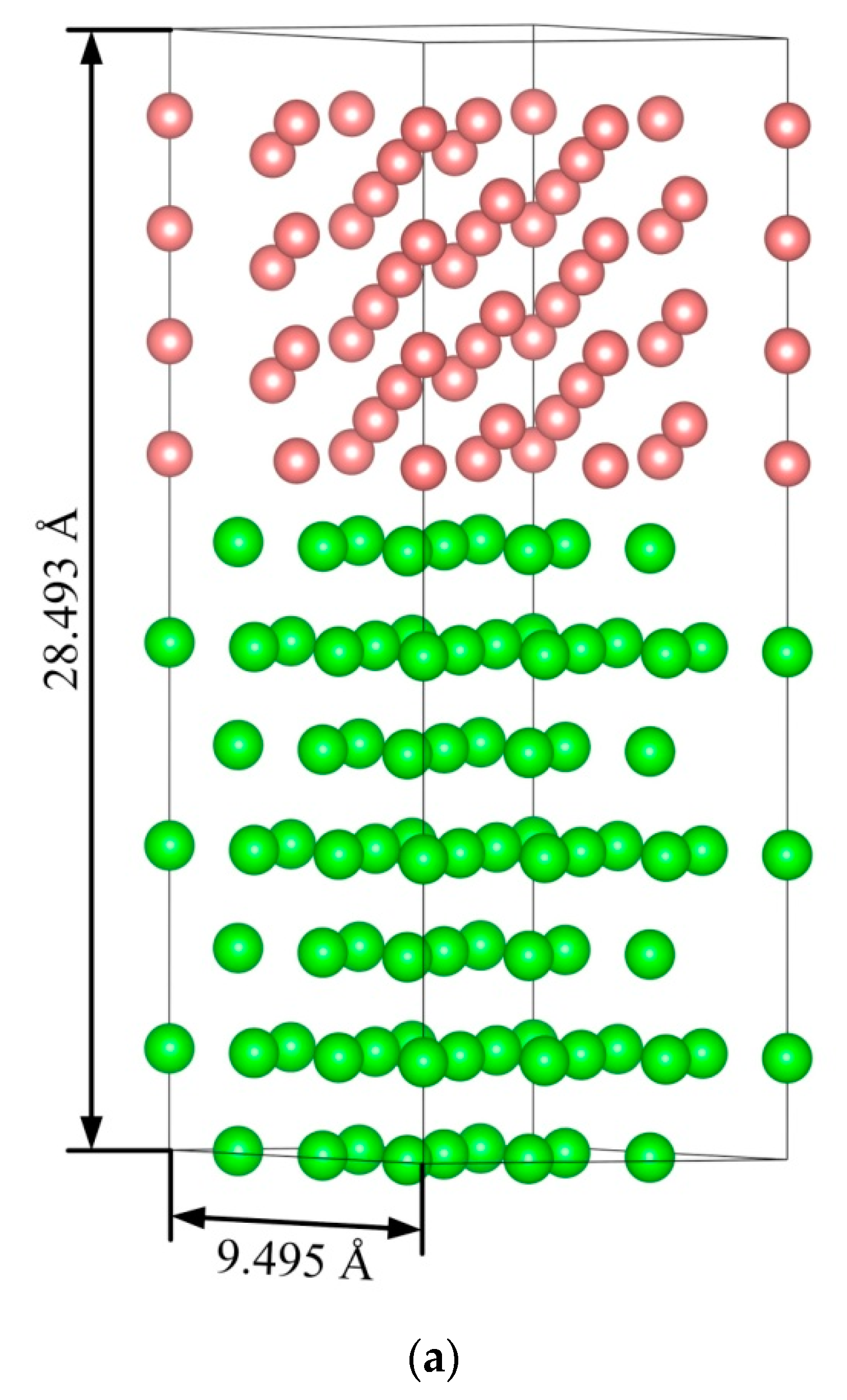
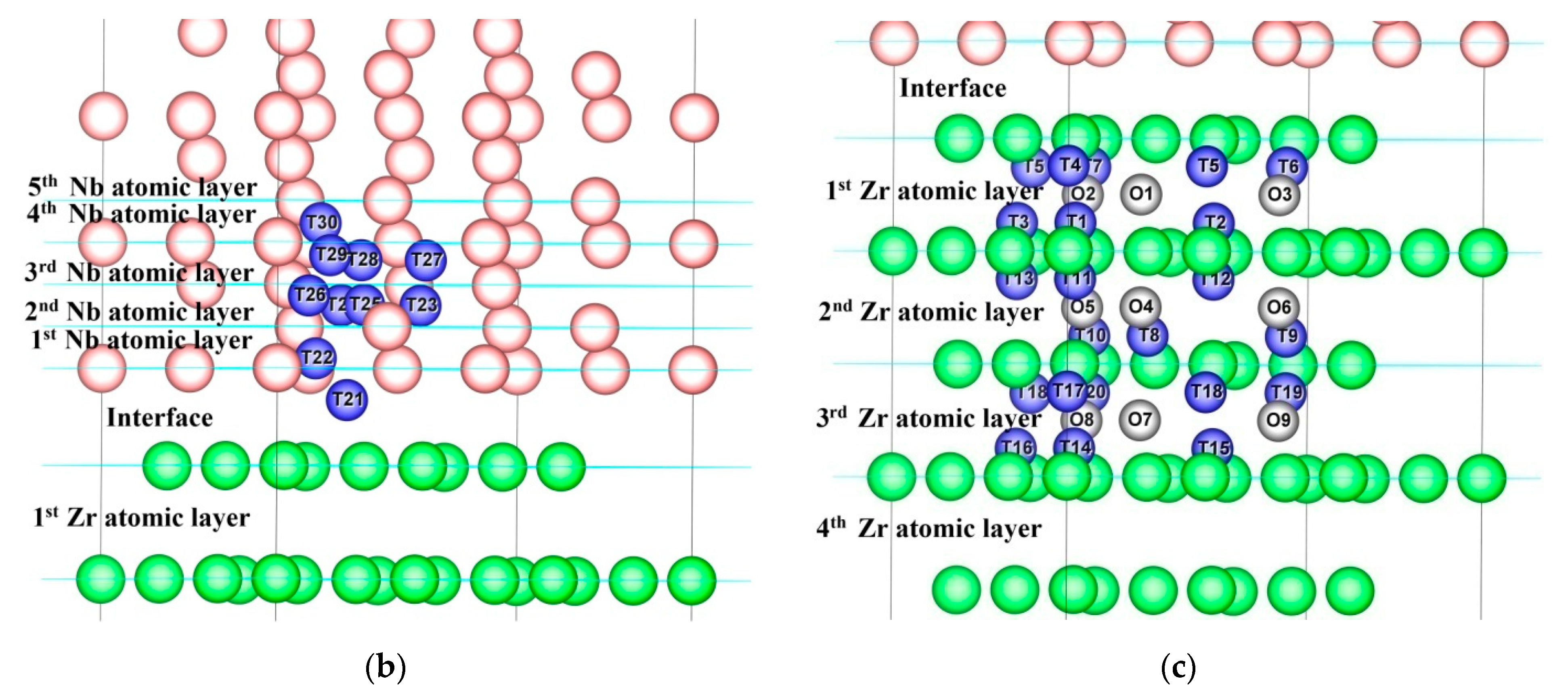
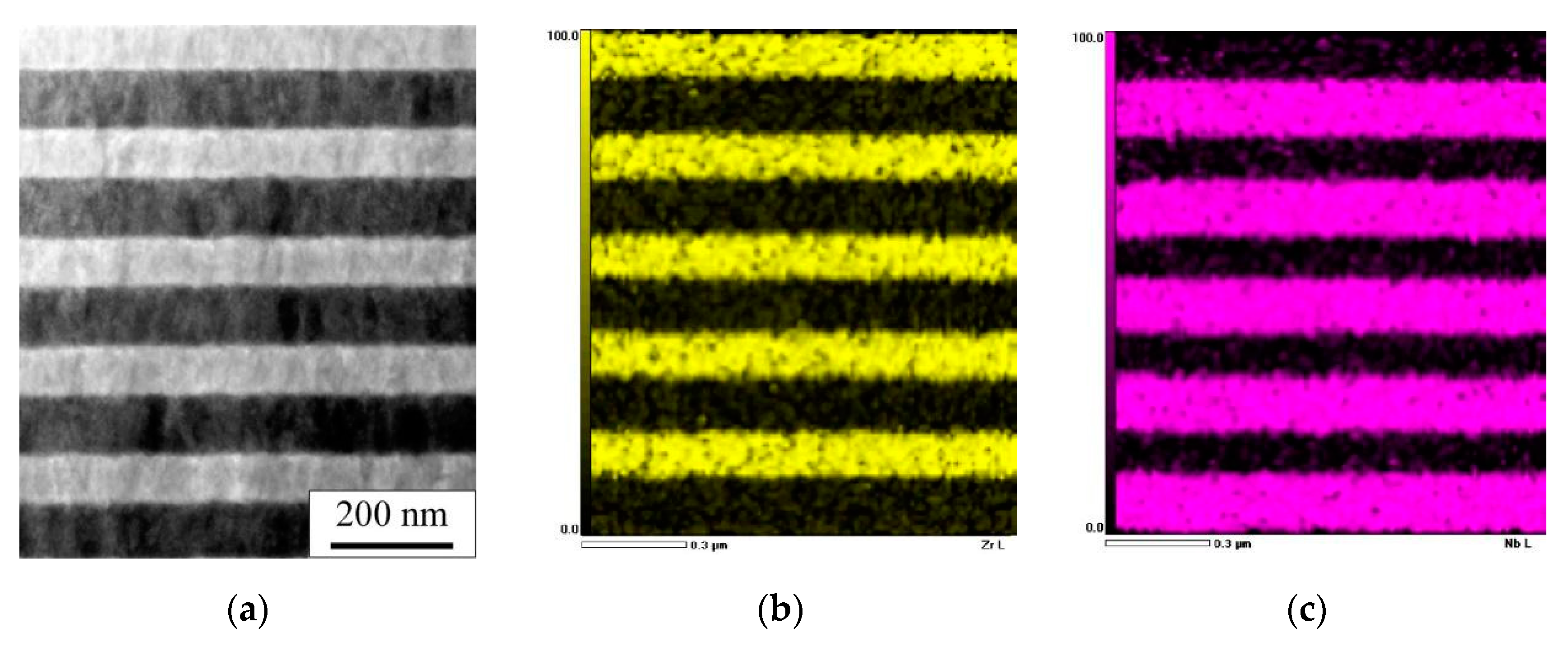
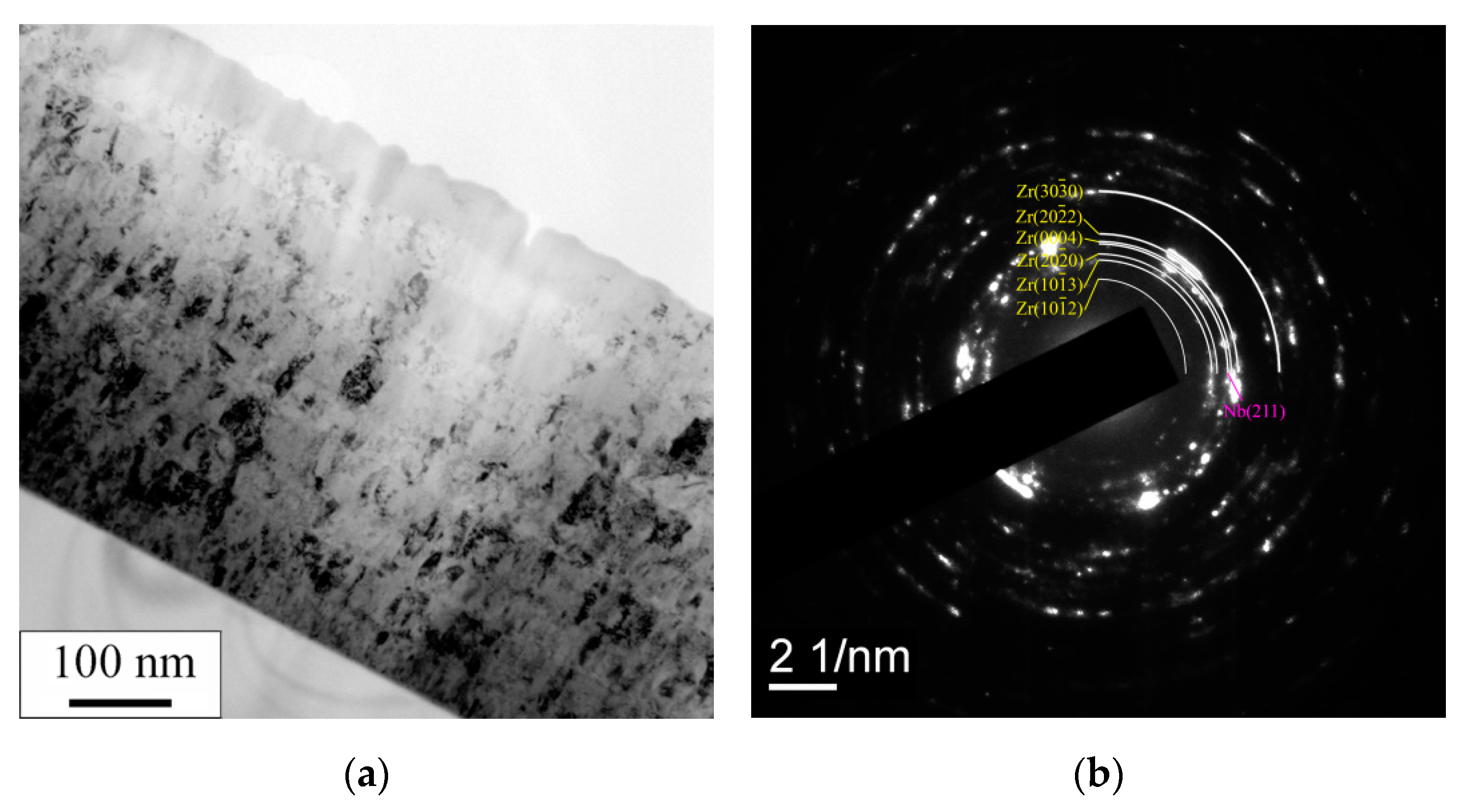
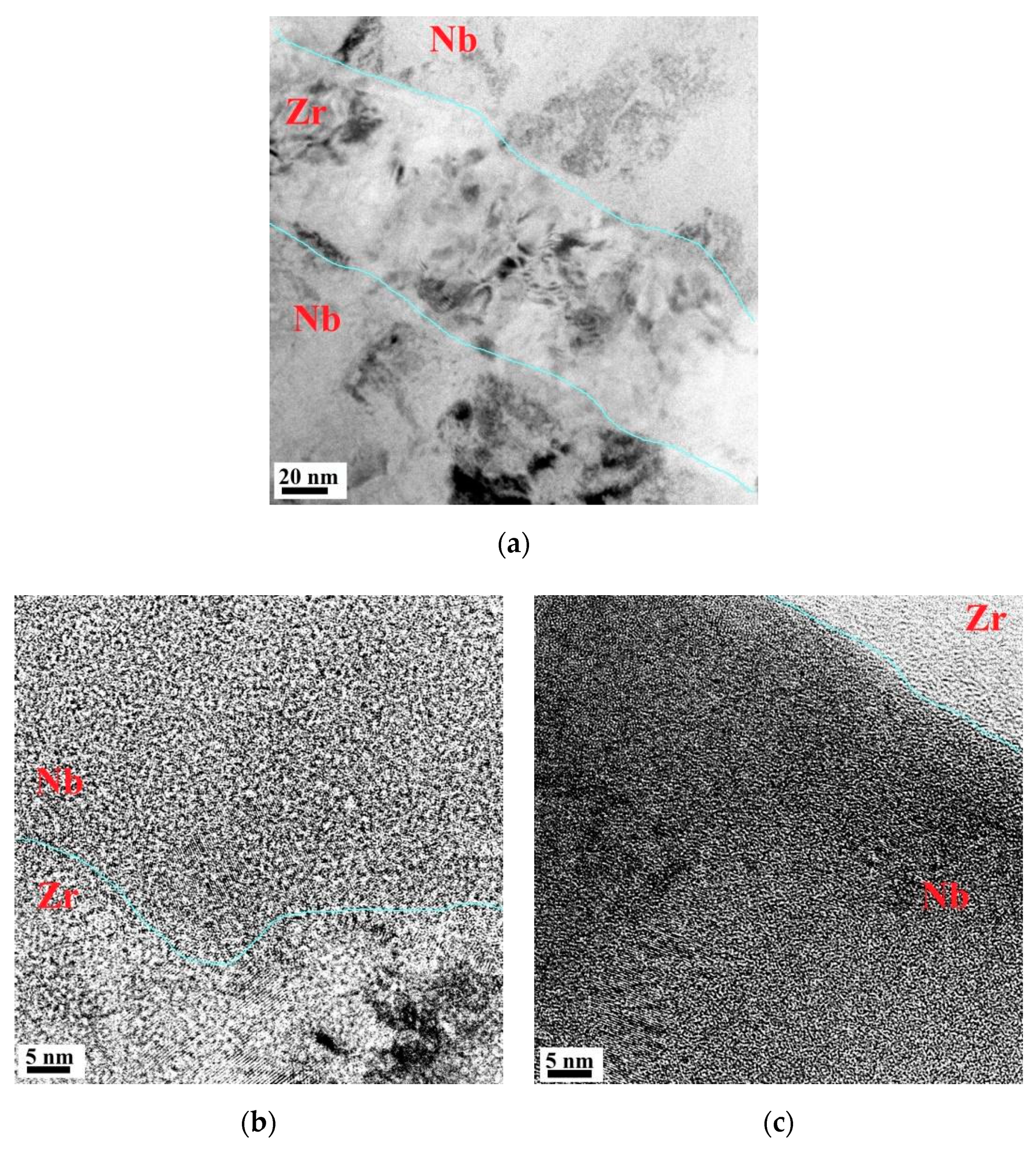
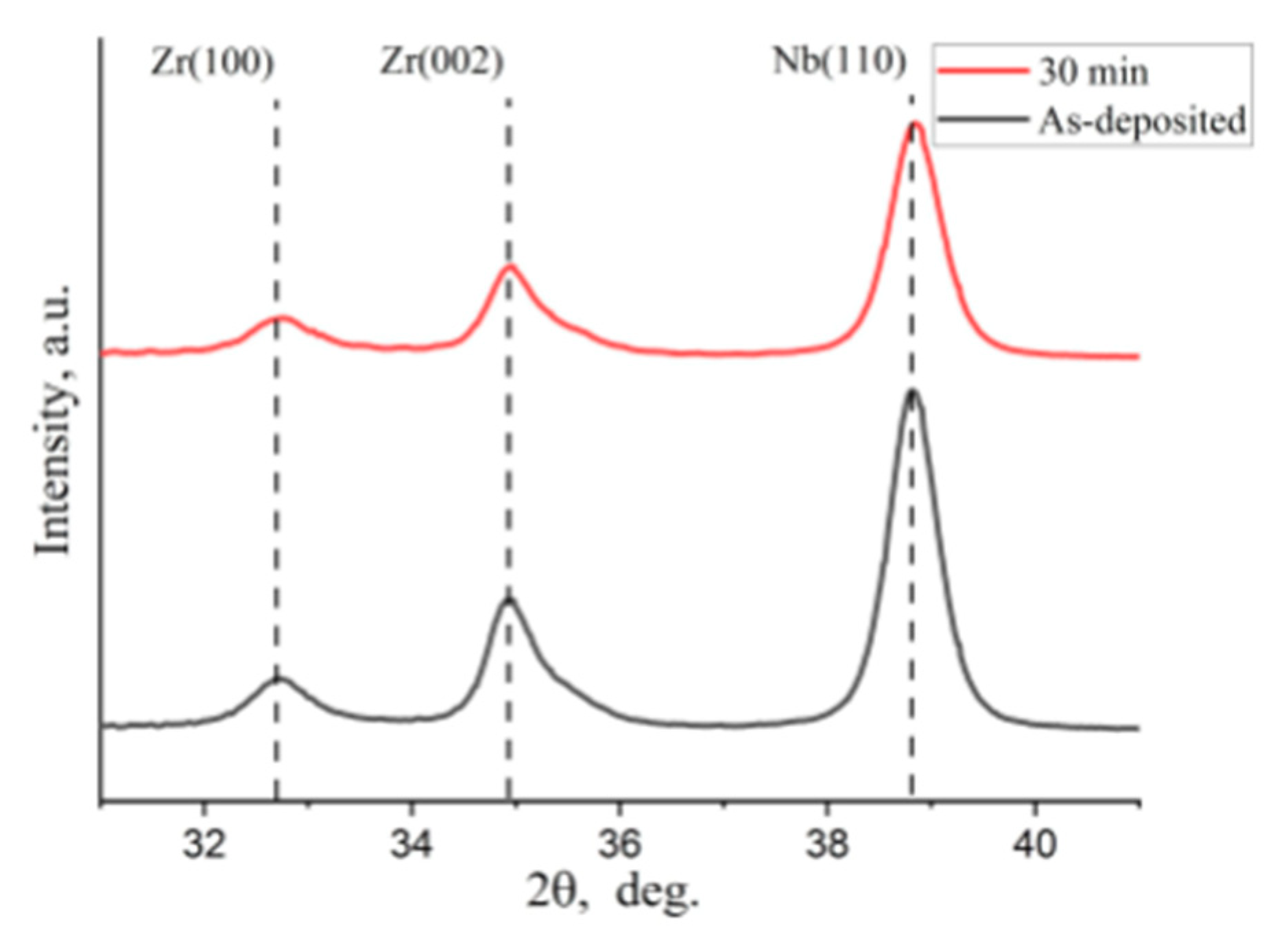
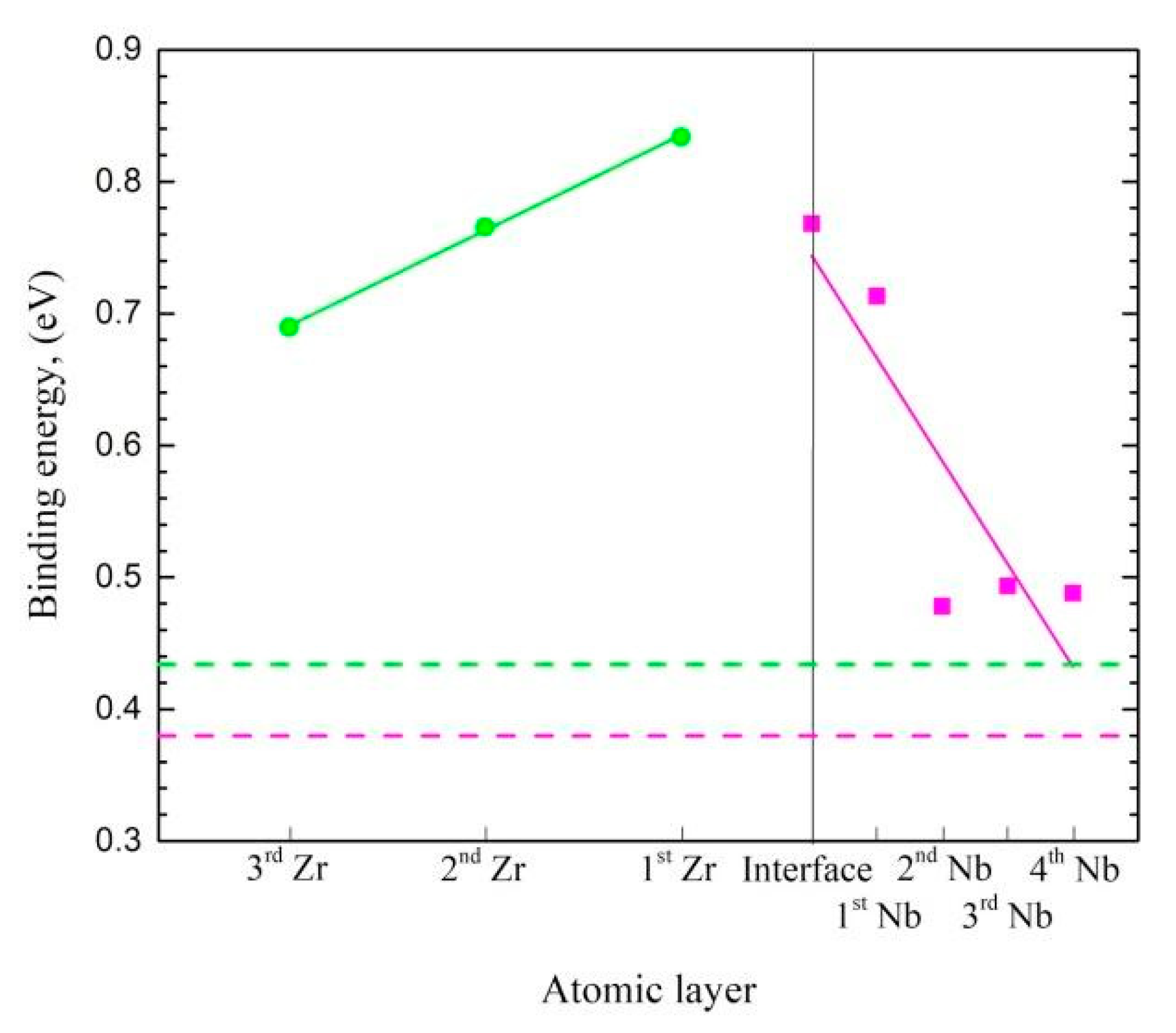
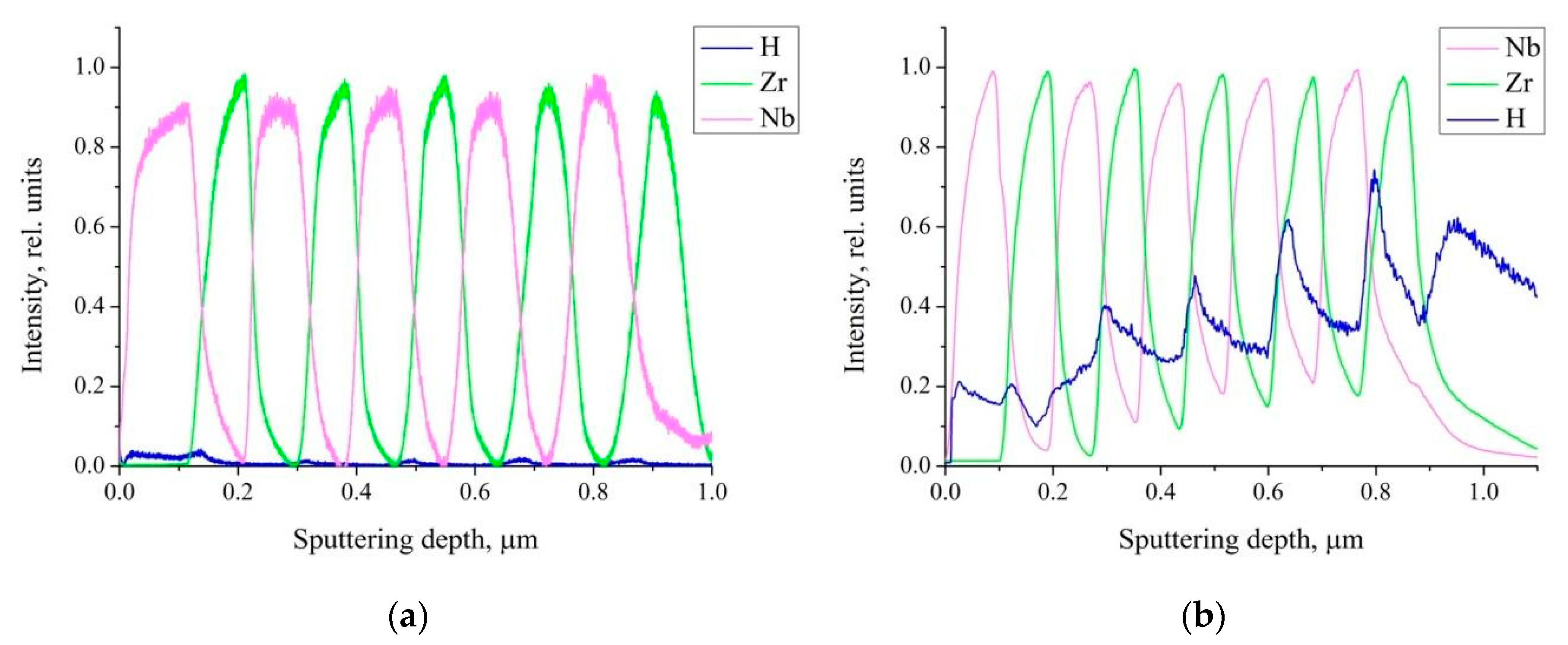
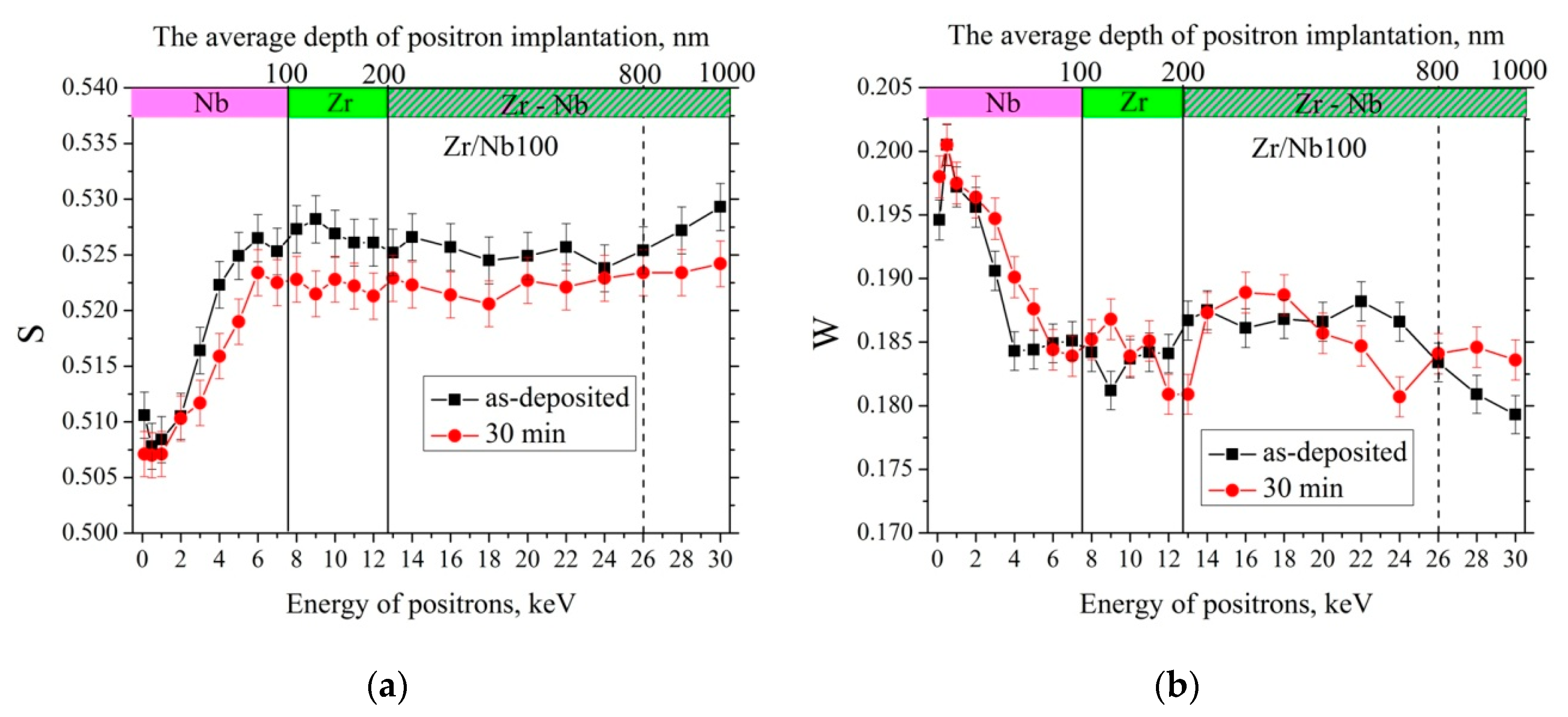
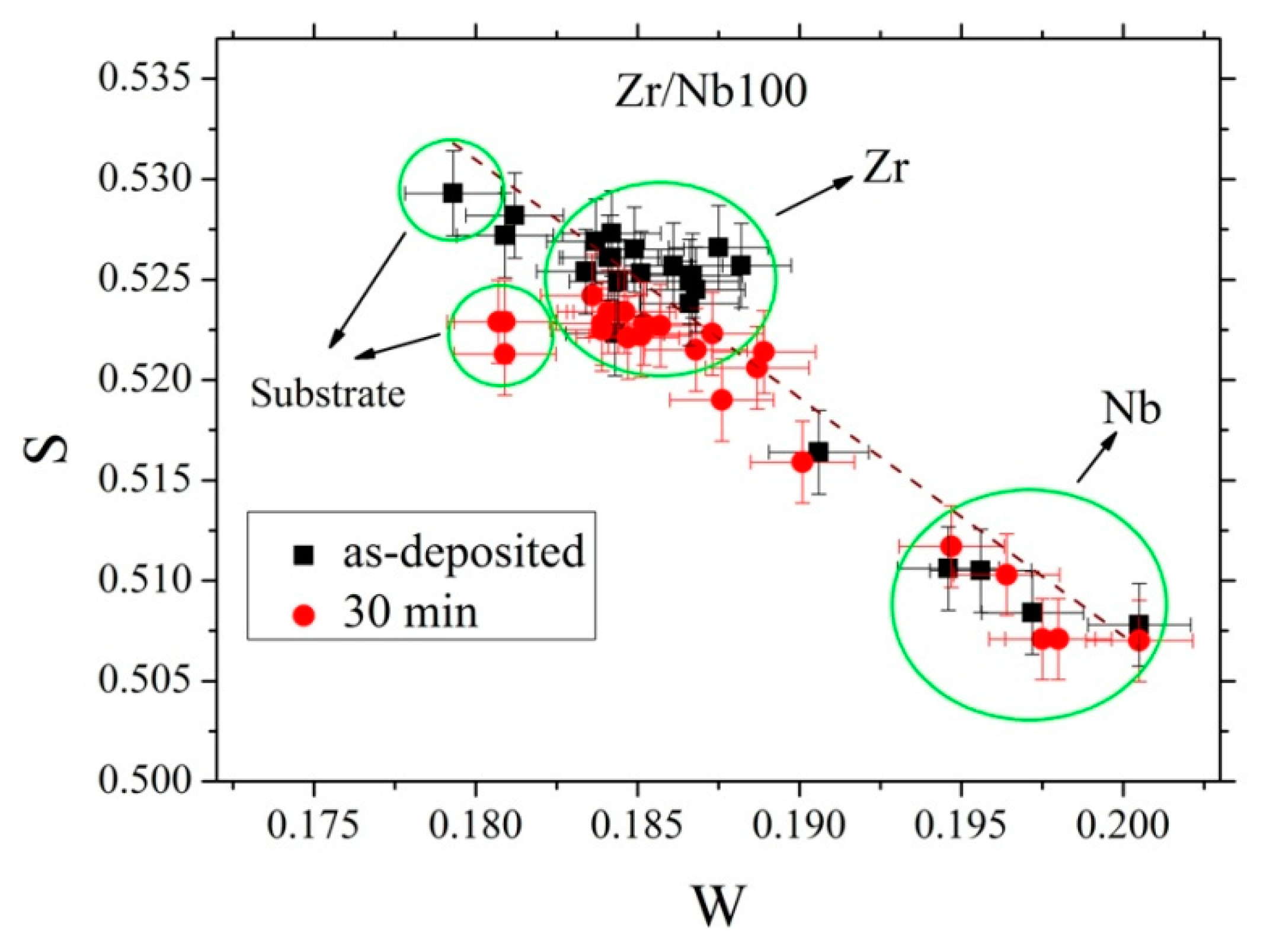
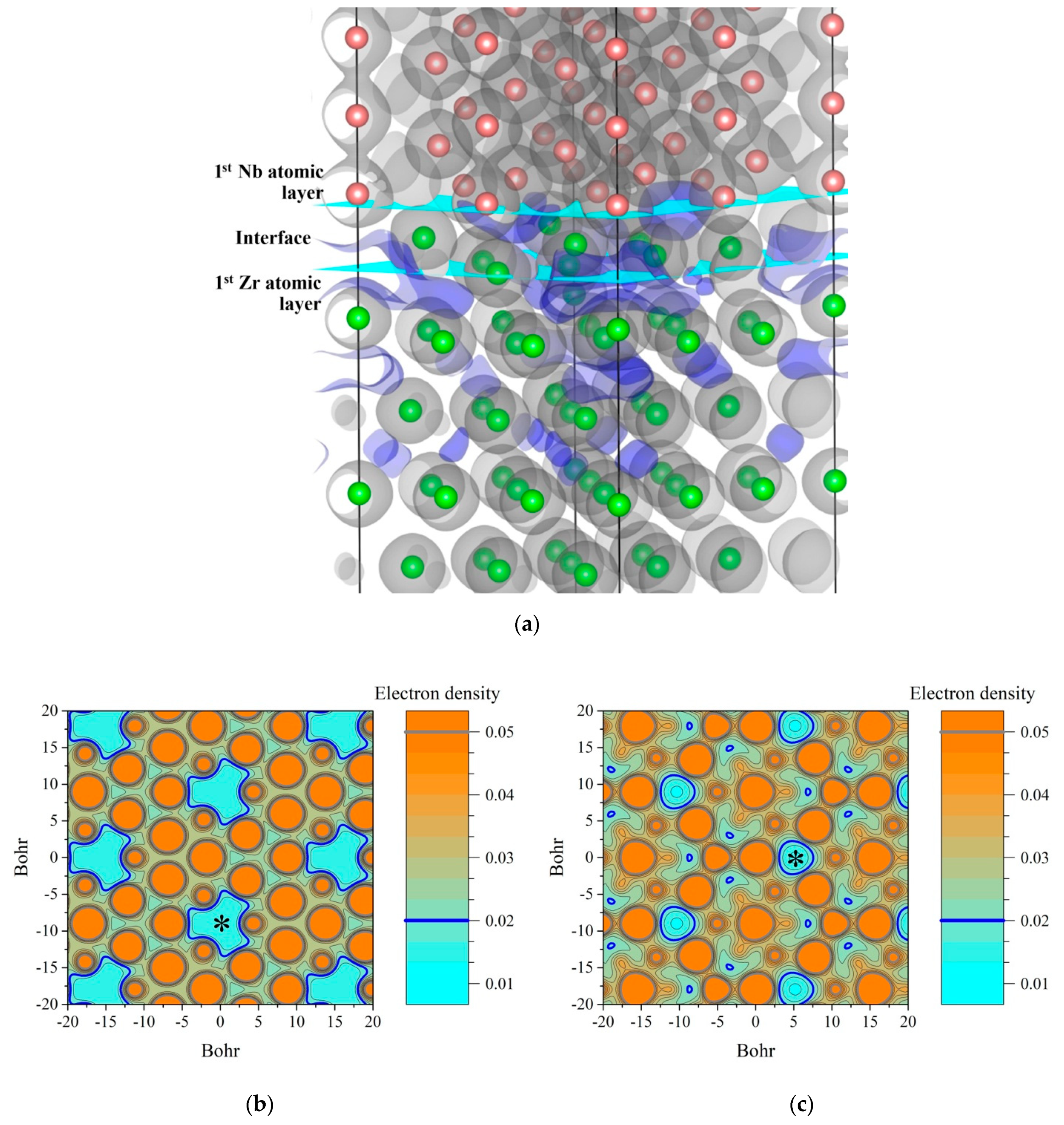
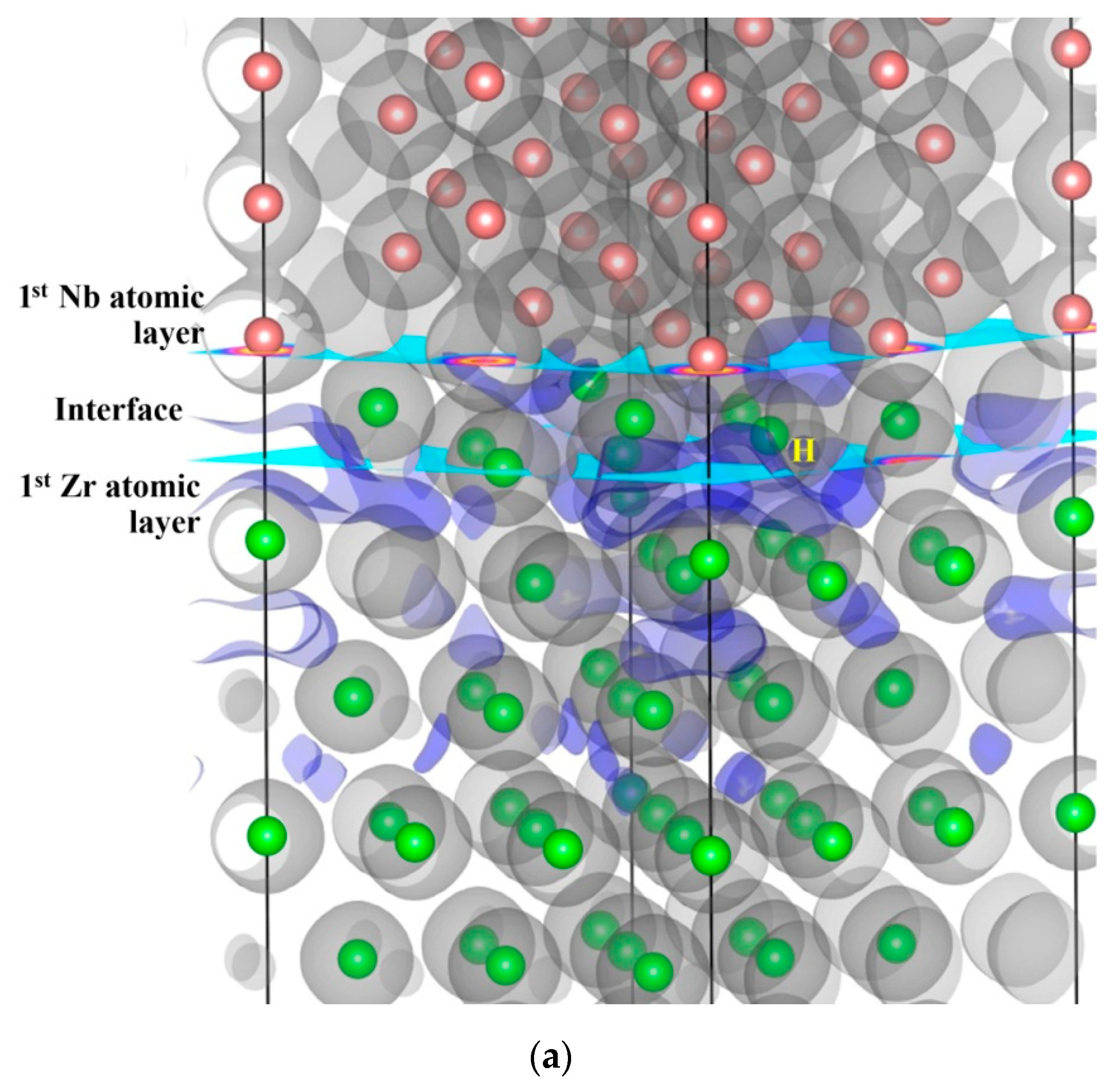
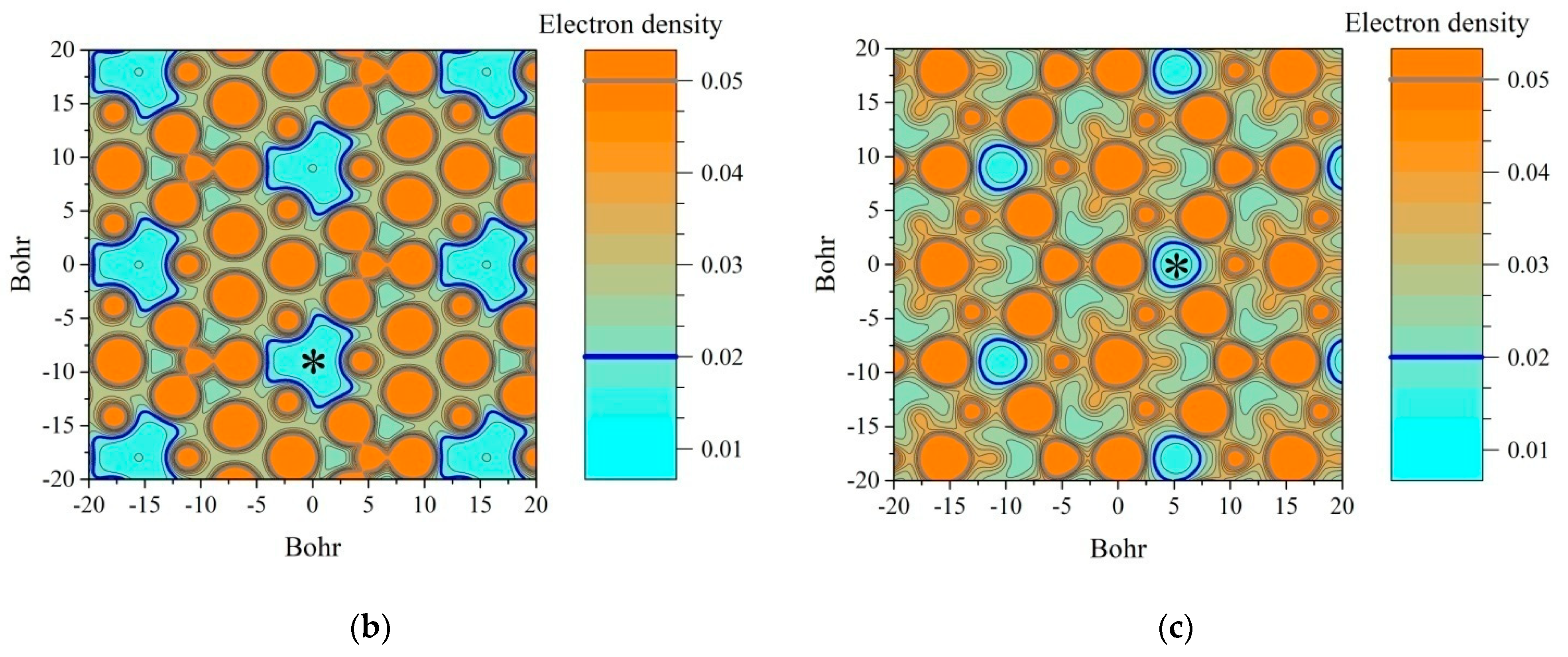

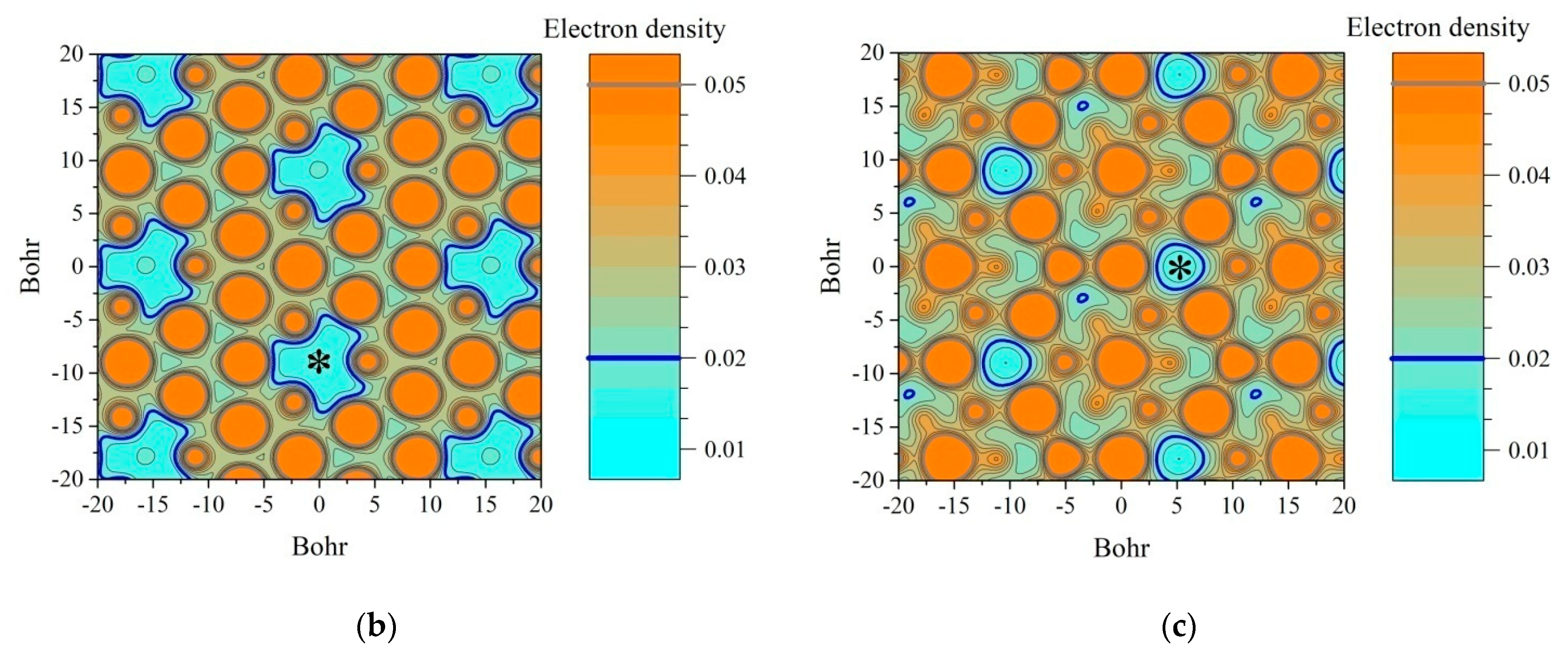
| System | Lattice Parameters, (Å) | |
|---|---|---|
| Actual Work | Other Calculations | |
| Zr | a = 3.228 | a = 3.213 [22] |
| c = 5.195 | c = 5.157 [22] | |
| Zr36H (H atom in T site) | a = 3.229 | a = 3.245 [22] |
| c = 5.203 | c = 5.218 [22] | |
| Zr36H (H atom in O site) | a = 3.228 | a = 3.240 [22] |
| c = 5.199 | c = 5.203 [22] | |
| Nb | a = 3.292 | a = 3.32 [23] |
| Nb36H (H atom in T site) | a = 3.294 | – |
| Nb36H (H atom in O site) | a = 3.294 | – |
| Site | Eb, (eV) | Site | Eb, (eV) | Site | Eb, (eV) | Site | Eb, (eV) |
|---|---|---|---|---|---|---|---|
| Zr36H Solid Solution | Nb36H Solid Solution | ||||||
| T | 0.459 0.45 [22] | O | 0.409 0.35 [22] | T | 0.380 | O | 0.160 |
| Zr63Nb40H slab | |||||||
| O1 | 0.970 | O4 | 0.765 | O7 | 0.731 | T21 | 0.768 |
| O2 | 0.758 | O5 | 0.769 | O8 | 0.748 | T22 | 0.713 |
| O3 | 0.800 | O6 | 0.762 | O9 | 0.672 | T23 | 0.511 |
| T1 | 1.007 | T8 | 0.786 | T14 | 0.760 | T24 | 0.554 |
| T2 | 0.822 | T9 | 0.809 | T15 | 0.697 | T25 | 0.498 |
| T3 | 0.656 | T10 | 0.551 | T16 | 0.649 | T26 | 0.349 |
| T4 | 0.816 | T11 | 0.963 | T17 | 0.513 | T27 | 0.517 |
| T5 | 0.788 | T12 | 0.832 | T18 | 0.752 | T28 | 0.477 |
| T6 | 1.035 | T13 | 0.655 | T19 | 0.644 | T29 | 0.486 |
| T7 | 0.653 | - | - | T20 | 0.618 | T30 | 0.488 |
Publisher’s Note: MDPI stays neutral with regard to jurisdictional claims in published maps and institutional affiliations. |
© 2021 by the authors. Licensee MDPI, Basel, Switzerland. This article is an open access article distributed under the terms and conditions of the Creative Commons Attribution (CC BY) license (https://creativecommons.org/licenses/by/4.0/).
Share and Cite
Laptev, R.; Svyatkin, L.; Krotkevich, D.; Stepanova, E.; Pushilina, N.; Lomygin, A.; Ognev, S.; Siemek, K.; Uglov, V. First-Principles Calculations and Experimental Study of H+-Irradiated Zr/Nb Nanoscale Multilayer System. Metals 2021, 11, 627. https://doi.org/10.3390/met11040627
Laptev R, Svyatkin L, Krotkevich D, Stepanova E, Pushilina N, Lomygin A, Ognev S, Siemek K, Uglov V. First-Principles Calculations and Experimental Study of H+-Irradiated Zr/Nb Nanoscale Multilayer System. Metals. 2021; 11(4):627. https://doi.org/10.3390/met11040627
Chicago/Turabian StyleLaptev, Roman, Leonid Svyatkin, Dmitriy Krotkevich, Ekaterina Stepanova, Natalia Pushilina, Anton Lomygin, Sergei Ognev, Krzysztof Siemek, and Vladimir Uglov. 2021. "First-Principles Calculations and Experimental Study of H+-Irradiated Zr/Nb Nanoscale Multilayer System" Metals 11, no. 4: 627. https://doi.org/10.3390/met11040627
APA StyleLaptev, R., Svyatkin, L., Krotkevich, D., Stepanova, E., Pushilina, N., Lomygin, A., Ognev, S., Siemek, K., & Uglov, V. (2021). First-Principles Calculations and Experimental Study of H+-Irradiated Zr/Nb Nanoscale Multilayer System. Metals, 11(4), 627. https://doi.org/10.3390/met11040627







